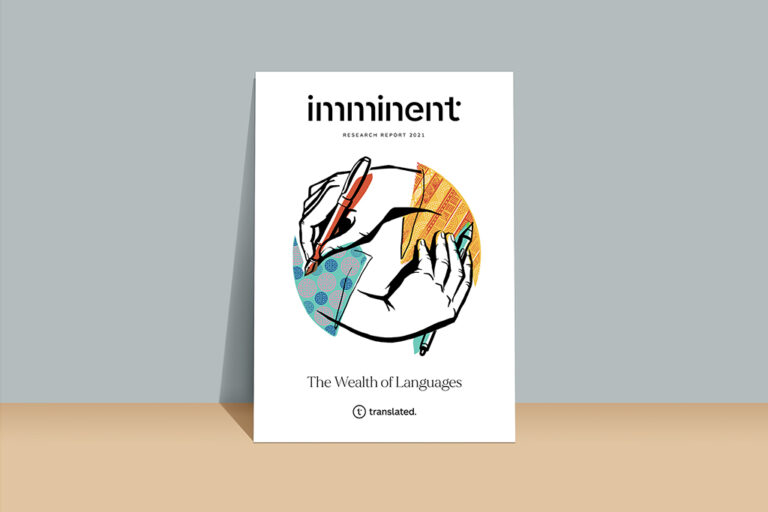Trends
In the great acceleration of history that the present world seems to have initiated, humanity is facing the greatest choices it has ever had to make. From climate change to managing pandemics, these choices have something in common: either humans face them and solve them together, or they turn them into their most epic failures. And the essential precondition for collaborative decision-making is that humans understand each other.
Languages are an invaluable cultural treasure. They can also be a huge barrier to understanding among humans. But if this difficulty were overcome, if everyone could express themselves well in their language, be understood and understand others, wouldn’t everything be simpler? Translated’s mission is to contribute to this simplification.
Let’s start with some beliefs.
1. If we could create a technology capable of interpreting languages with the same quality as professional translators, a technology that can produce instant translations at an affordable price for all humans on earth, we would have a huge impact, allowing people to understand and be understood by others, whatever language they speak. One of the great problems of humanity would be solved.
2. English is not a solution. The share of people who speak English is decreasing, not increasing. This is because the speed at which people learn English is lower than the speed at which new people are entering the connected world. People who speak their native language. The phenomenon is obvious, and it’s also fair: if everyone were to speak English, some would have an unfair competitive advantage. Those born in certain parts of the world would hold an advantage over others. In a multilingual world, everyone competes on an equal footing. Not all languages will survive, but hundreds of languages will remain.
3. The number of people doing business in the international market is growing. And it will grow more and more, so more and more people will need a translation service.
4. There are two directions in communication: understanding others and being understood by others. To understand others, you don’t need to expect a lot from translation systems. But to be understood, you need to have translations of the highest professional quality. This means the problem of understanding will be solved faster than the problem of being understood.
In short, we are building a system for instant translation, with the quality of the best professional translators in the world and at a price that is close to free, to the extent that everyone can access this technology, regardless of where they live and how much they earn.
To achieve this, we need data, we need machines with a brain as powerful as a human’s, and we need learning algorithms that make computers capable of learning languages like humans do.
How far along are we?
The processing capacity of computers today is ten thousand times less than the human brain. Computers today are the size of a mouse’s brain. And they already know how to translate fairly well, which means we’ve managed to teach mice to speak. However, the inferiority of computers is destined to be short-lived. Thanks to Moore’s Law – and perhaps the prospect of the quantum computer – in 2035, according to Ray Kurzweil, or in 2045 per other estimates, the computer will be as powerful as the human brain.
As far as data collection is concerned, we know that a human brain learning a language from the age of 0 to 30 can process at least 2 billion words. For some languages, we can feed computers with 5-7 billion words of excellent professional quality. For many other languages we are way, way behind.
Finally, when it comes to the efficiency of learning algorithms, machines are less efficient than the brain, but not by much: 10-20% less. Of course, machines don’t have a plastic cognitive system – one that changes with experience – but they know how to learn quite well. And they will improve.
We can say, therefore, that a computer that translates perfectly could plausibly be with us by 2050. To support the world’s 24 main languages, however, such a computer could be created as early as 2040. And before this, we can make great strides for certain languages. Putting together ten thousand computers to process translations between languages for which data is already abundant could also be a project worth funding. Improving the algorithms to bring them up to the level of humans is feasible in a few years: after all, in the past there have already been great leaps, from algorithms based on the rules of languages to statistical algorithms, and then to neural algorithms.

Imminent Annual Report 2021
Fit your business in global shape. Get your copy of Imminent Annual Research Report 2021. And let us know what you think.
Get your copy nowMaking available to the public a system that allows humans to understand each other, that works instantly and at a price of practically nothing, is a goal worth dedicating a lifetime of work to. Translated is investing to make this project a reality. And in the meantime, to discuss, nurture, support, criticise and improve this multilingual culture, where the professionalism of humans and the power of machines work together in symbiosis, Translated has created its own research centre, Imminent. We have so much to learn. Enjoy.
Photo credits: Ali Shah Lakhan Unsplash
